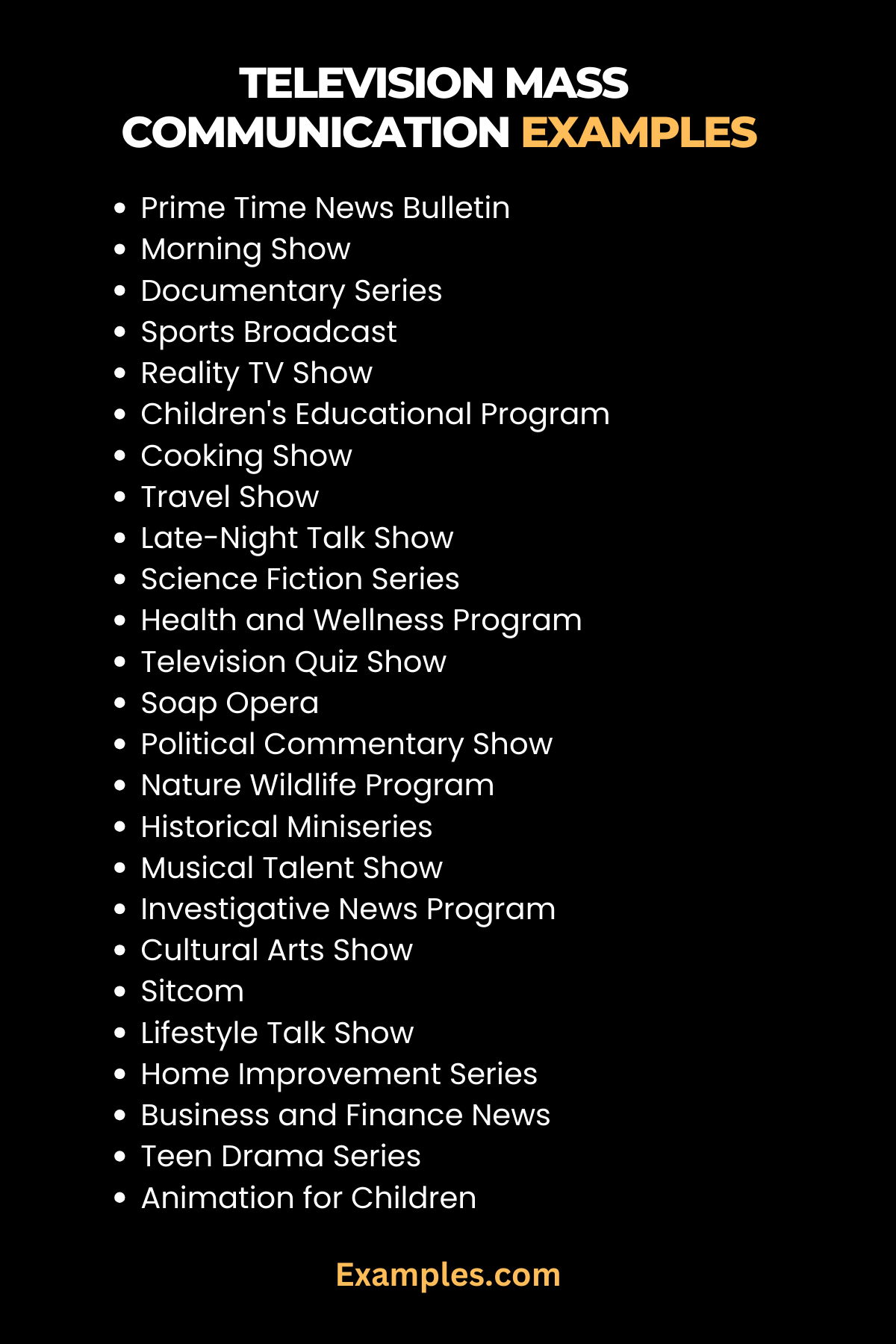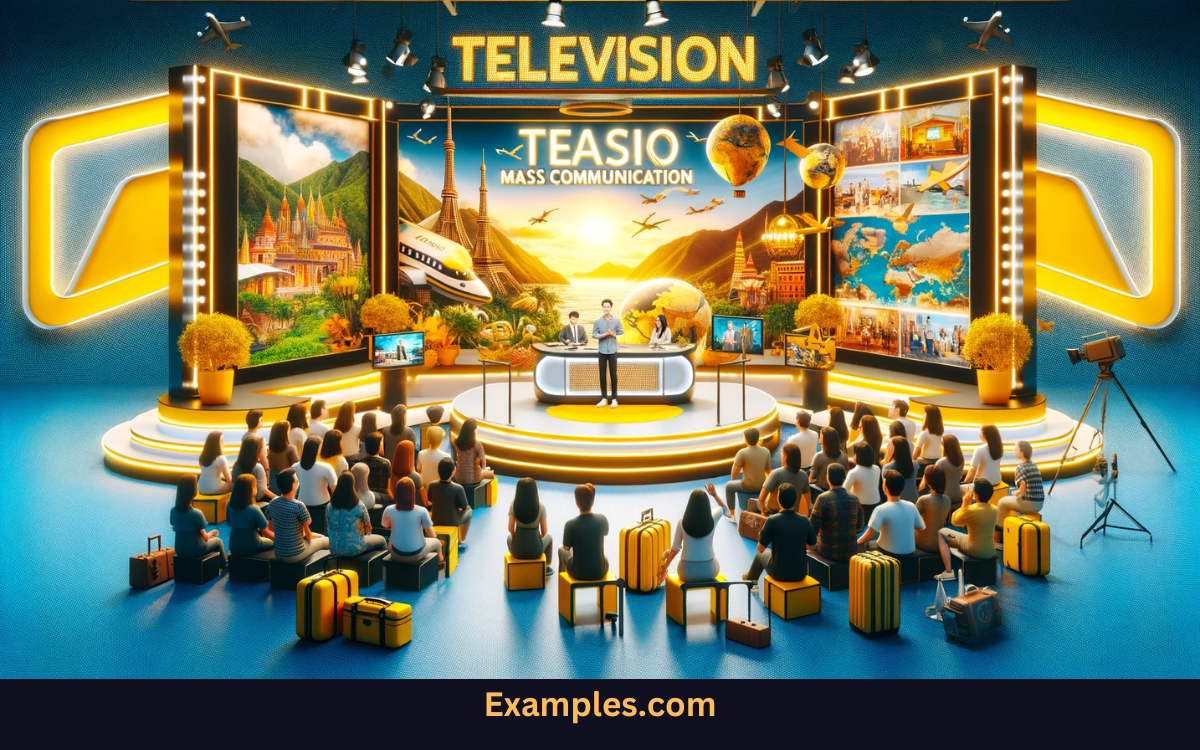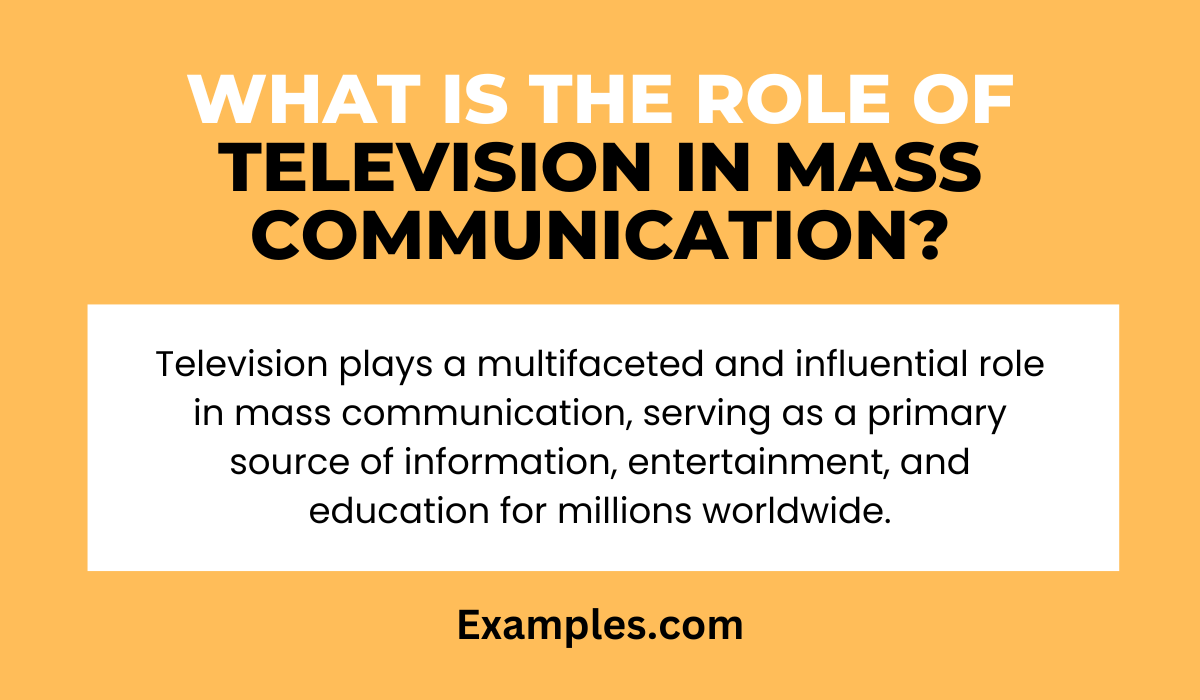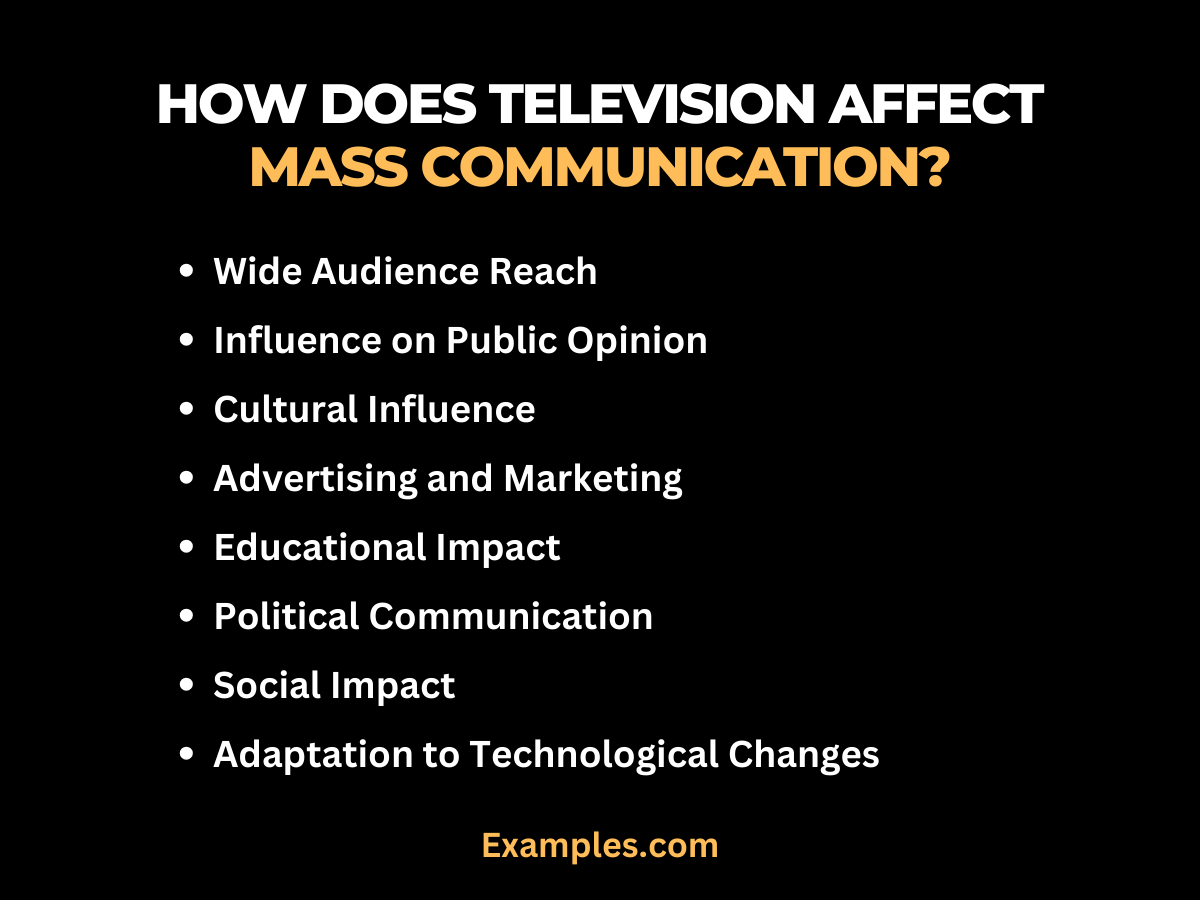29+ Television Mass Communication Examples
Television mass communication stands as a pivotal medium in the realm of media, blending entertainment with information dissemination. This guide delves into the intricacies of TV broadcasting, exploring how it shapes public opinion and culture. From news bulletins to captivating dramas, television offers diverse communication examples, each with its unique influence and appeal. Learn about the strategies behind successful TV programming, audience engagement, and the evolving landscape of television in the age of digital transformation, all crucial for mastering media communication.
What is Television in Mass Communication?
Television in mass communication is a powerful medium used to disseminate information, entertainment, and educational content to a large audience through electronic signals. It’s a key tool in media communication, combining visual and audio elements to present stories, news, and information. Television plays a crucial role in shaping public opinion, reflecting cultural values, and providing a platform for advertising. As a widespread and influential medium, it reaches households globally, making it a significant component in the broadcasting landscape.
30 Television Mass Communication Examples
Television, as a cornerstone of mass communication, offers a myriad of content forms, each serving unique purposes in informing, educating, and entertaining diverse audiences. This compilation of 30 examples showcases the versatility and impact of television as a powerful medium in the broadcasting landscape. From news bulletins to reality shows, each format employs specific communication strategies to engage viewers, reflecting the dynamic nature of media communication.

- Prime Time News Bulletin: “Bringing you the day’s top stories from around the world, every evening at 8 PM.” Evening news programs provide comprehensive updates on national and international events.
- Morning Show: “Start your day with a mix of news, weather, and lifestyle segments on ‘Morning Buzz’.” Morning shows blend news updates with light entertainment and discussions.
- Documentary Series: “Explore untold stories in our weekly documentary series ‘Real World’.” Documentaries offer in-depth exploration on a range of topics.
- Sports Broadcast: “Catch live action and expert commentary on the Premier League every weekend.” Sports broadcasts provide live coverage and analysis of sporting events.
- Reality TV Show: “Tune in to ‘Life Unscripted’ and follow the real-life drama every Tuesday night.” Reality shows focus on unscripted, real-life situations and personal stories.
- Children’s Educational Program: “Join us for fun learning adventures on ‘Kids Discover’ every morning.” Programs for children combine entertainment with educational content.
- Cooking Show: “Master new recipes with celebrity chefs on ‘Culinary Delights’.” Cooking shows feature cooking demonstrations and culinary tips.
- Travel Show: “Explore exotic destinations on ‘Wanderlust’ every Sunday evening.” Travel shows take viewers on journeys to various locations worldwide.

- Late-Night Talk Show: “Enjoy celebrity interviews and comedy sketches on ‘After Hours’.” Late-night shows feature interviews and entertainment segments.
- Science Fiction Series: “Dive into futuristic adventures on our sci-fi series ‘Galaxy Quest’.” Sci-fi series explore imaginative and futuristic concepts.
- Health and Wellness Program: “Discover health tips and wellness advice on ‘Live Well’.” Focus on health-related content, offering advice and information.
- Television Quiz Show: “Test your knowledge on ‘Brain Teasers’, every Wednesday at 7 PM.” Quiz shows engage audiences with trivia and competitions.
- Soap Opera: “Experience the drama and romance in ‘Hearts Entwined’, every weekday.” Soap operas present serialized fictional stories and emotional drama.
- Political Commentary Show: “Get insights into political developments on ‘Capitol Voices’.” Offers analysis and discussion on political events and policies.
- Nature Wildlife Program: “Witness the beauty of nature on ‘Wild Planet’.” Focuses on wildlife and natural environments.
- Historical Miniseries: “Explore historical events in our miniseries ‘Times Past’.” Dramatizes historical events and figures.
- Musical Talent Show: “Watch aspiring singers compete on ‘Star Voice’.” Showcases musical performances and competitions.
- Investigative News Program: “Uncover the truth with ‘Investigate Now’.” Delivers in-depth investigative journalism on various issues.

- Cultural Arts Show: “Celebrate arts and culture on ‘Canvas of Creativity’.” Highlights artistic endeavors and cultural events.
- Sitcom: “Laugh along with ‘Everyday Funnies’, Friday nights at 9.” Sitcoms are comedy series based on everyday life scenarios.
- Lifestyle Talk Show: “Join us on ‘Life & Style’ for the latest lifestyle trends.” Discusses lifestyle topics, fashion, and culture.
- Home Improvement Series: “Transform your space with ‘Home Makeover’.” Focuses on home renovation and decoration tips.
- Business and Finance News: “Stay updated with ‘Market Watch’ every weekday.” Provides news and analysis on business and finance.
- Teen Drama Series: “Follow teenage struggles in ‘High School Chronicles’.” Revolves around issues and experiences of teenagers.
- Animation for Children: “Enter a world of imagination with ‘Cartoon Carnival’.” Animated content specifically created for children.
- Music Video Countdown: “Catch the top music hits on ‘Video Countdown’.” Plays and ranks current popular music videos.
- Educational Science Show: “Learn about scientific wonders on ‘Science Today’.” Educational content focused on scientific topics and discoveries.
- Crime Drama Series: “Unravel mysteries on ‘Detective Diaries’.” Centers around crime, investigation, and mystery themes.
- Social Issue-Based Program: “Addressing today’s challenges on ‘Society Speaks’.” Discusses and explores various social issues.
- Biographical Series: “Discover the lives of notable figures on ‘Biography Spotlight’.” Chronicles and dramatizes the lives of famous personalities.
What is the Role of Television in Mass Communication?
Television plays a multifaceted and influential role in mass communication, serving as a primary source of information, entertainment, and education for millions worldwide. In the vast landscape of media communication, television’s impact is profound and far-reaching, making it a cornerstone in the dissemination of content.

Information Dissemination
- News Broadcasting: Television is crucial in broadcasting news, providing viewers with timely and comprehensive updates on local, national, and global events.
- Current Affairs Programming: Through documentaries, talk shows, and analytical programs, television offers in-depth insights into current issues, contributing significantly to public knowledge and awareness.
Entertainment
- Diverse Programming: From drama series and comedies to reality shows and movies, television offers a wide range of entertainment options, catering to diverse audience preferences.
- Cultural Impact: Television programs often reflect and influence cultural trends and societal values, playing a key role in shaping public opinion and entertainment standards.
Education and Awareness
- Educational Content: Educational programs, especially for children, combine learning with entertainment, making television a valuable tool in informal education.
- Public Service Announcements: TV is used for broadcasting PSAs, raising awareness about important social, health, and safety issues.
Advertising and Marketing
- Commercial Advertising: Television is a powerful platform for advertisers, allowing brands to reach a wide audience through commercials and sponsored content.
- Product Placement: Integrating products or brands within TV shows is another strategy that influences consumer behavior and brand recognition.
Social Connection
- Shared Experiences: Television brings people together, offering shared experiences through live events like sports, award shows, and ceremonies.
- Community Building: Certain TV programs create communities of fans, fostering social interaction and discussion around shared interests.
Political Influence
- Political Campaigns: Television is a critical tool in political communication, used by politicians and parties to reach voters and influence public opinion.
- Debate and Analysis: Political debates and analysis programs on TV contribute to the democratic process by informing and engaging citizens.
Technological Evolution
- Adaptation to Digital Trends: With the advent of digital technology, television has adapted to include streaming services, offering content on-demand and reaching a wider, internet-savvy audience.
- Innovative Formats: The integration of interactive elements and high-definition broadcasting keeps television at the forefront of technological advancements in media.
Television’s role in mass communication is comprehensive and dynamic, encompassing information dissemination, entertainment, education, advertising, social connection, political influence, and continuous technological evolution. Its ability to combine visual and auditory elements makes it one of the most powerful and persuasive forms of mass communication in the modern world.
Why is Television as a Medium of Mass Communication?
Television, since its inception, has been a cornerstone of mass communication, influencing and shaping public opinion, culture, and society on a global scale. As a medium, it possesses unique qualities that make it an integral part of daily life and an effective tool for mass communication.

Wide Reach and Accessibility
- Global Audience: Television reaches a vast and diverse audience worldwide, transcending geographical boundaries.
- Easy Accessibility: It is easily accessible to a majority of the population, making it a primary source of information and entertainment for many households.
Visual and Auditory Appeal
- Engaging Content: Television combines visual imagery with sound, creating an engaging experience that captivates viewers.
- Emotional Impact: This audio-visual appeal allows for a stronger emotional connection with the audience, making messages more impactful.
Versatility in Content
- Diverse Programming: TV offers a wide range of content, from news and documentaries to entertainment and educational programs.
- Adaptability: Television adapts to various genres and formats, appealing to different age groups, interests, and cultural backgrounds.
Influence on Public Opinion
- Informative Role: As a medium, it plays a crucial role in informing the public about current events, issues, and developments.
- Shaping Views: Television has the power to shape public opinion and influence societal norms and values.
Advertising and Marketing Platform
- Commercial Use: It serves as an effective platform for advertising, reaching millions of potential consumers.
- Brand Promotion: Television advertising helps in brand promotion, product launches, and marketing campaigns.
Source of Credibility
- Trusted Medium: Television is often perceived as a credible source of information.
- Authoritative Content: The presence of expert opinions, live reporting, and in-depth analysis adds to its reliability.
Role in Education and Awareness
- Educational Programs: TV broadcasts educational content that can supplement traditional learning.
- Awareness Campaigns: It is instrumental in public awareness campaigns, covering health, social issues, and public welfare.
Impact on Culture and Entertainment
- Cultural Exchange: Television facilitates cultural exchange by showcasing diverse cultural content.
- Entertainment Value: It remains a primary source of entertainment, offering various shows, movies, and series.
Television’s status as a powerful medium of mass communication stems from its broad reach, engaging content format, versatility, and influential role in shaping public perception and culture. Its ability to adapt to technological advancements and changing viewer preferences further cements its position as a vital component of the mass media ecosystem.
How Does Television Affect Mass Communication?
Television has had a profound impact on mass communication, shaping how information is disseminated and how audiences consume content. As a dominant medium, it has transformed the landscape of media communication, influencing public opinion, culture, and societal norms.

Here’s an exploration of television’s effect on mass communication.
Wide Audience Reach
- Global Connectivity: Television connects diverse audiences globally, transcending geographical barriers. Its ability to reach millions simultaneously makes it a powerful tool in mass communication.
- Visual Impact: The combination of visuals and audio makes television an effective medium for storytelling, delivering messages that are more likely to be remembered and understood.
Influence on Public Opinion
- Shaping Perceptions: Television has the power to influence viewers’ perceptions and opinions, especially in areas like politics, social issues, and consumer choices.
- Setting Agendas: Through selective coverage, television can prioritize certain topics, shaping the public agenda and directing attention to specific issues.
Cultural Influence
- Cultural Exchange: TV programs often reflect cultural values and narratives, contributing to cultural exchange and understanding between different societies.
- Lifestyle Influence: Lifestyle and reality shows on television can have a significant impact on viewer’s lifestyle choices, fashion, and behavior.
Advertising and Marketing
- Promotional Platform: Television serves as an influential platform for advertising and marketing, reaching a wide audience with commercial messages.
- Brand Building: TV commercials play a crucial role in brand building, leveraging the medium’s visual and auditory appeal.
Educational Impact
- Informative Content: Educational programs on television provide learning opportunities across various age groups, covering topics from science to history.
- Awareness Creation: Television is instrumental in raising awareness about important social, health, and environmental issues.
Political Communication
- Election Campaigns: Television plays a critical role in political communication, especially during election campaigns, debates, and political coverage.
- Policy Communication: Governments and policymakers often use television to communicate policies and updates to the public.
Social Impact
- Social Awareness: Television programming can highlight and address social issues, influencing societal attitudes and sparking dialogue.
- Community Building: Certain TV shows and genres foster a sense of community among viewers, creating shared experiences and conversations.
Adaptation to Technological Changes
- Digital Integration: With the advent of digital technology, television has adapted to include streaming services, integrating traditional TV with online platforms.
- Interactive Content: Modern television also incorporates interactive elements, enhancing viewer engagement and participation.
Television’s influence on mass communication is multifaceted, affecting how societies communicate, interact, and perceive the world. Its role in entertainment, education, politics, and advertising demonstrates its enduring significance in the global communication ecosystem.
How to Use Television in Mass Communication
Television is a powerful medium in mass communication, known for its wide reach and ability to influence public opinion. Using television effectively in mass communication involves a strategic approach to content creation, audience engagement, and technological adaptation. Here’s a guide on how to utilize television to its fullest potential in the field of mass communication.
Understanding the Medium
- Audience Analysis: Understand the demographics and preferences of your target audience. Television caters to a diverse audience, making it crucial to tailor content accordingly.
- Content Variety: Recognize the versatility of television. From news to entertainment, educational to commercial, television can deliver a wide range of content.
Content Creation and Planning
- Engaging Storytelling: Develop content that tells compelling stories. Whether it’s a news piece or a drama series, effective storytelling is key to engaging viewers.
- Visual and Audio Appeal: Utilize the visual and auditory nature of television. High-quality visuals and clear sound are essential for captivating your audience.
Utilizing Different Television Formats
- Program Formats: Use various program formats like talk shows, documentaries, series, and live broadcasts to cater to different audience interests.
- Time Slot Consideration: Be mindful of the time slot. Different time slots cater to different viewership patterns and preferences.
Integrating with Digital Platforms
- Cross-Promotion with Digital Media: Use social media and online platforms to complement and promote your television content.
- Interactive Elements: Integrate interactive elements like social media polls or live tweets into your broadcast to increase audience engagement.
Audience Engagement and Feedback
- Viewer Feedback Mechanisms: Implement ways to gather viewer feedback, such as surveys or social media engagement, to understand viewer responses.
- Adapting Content Based on Feedback: Be adaptable and willing to adjust content based on audience feedback and trends.
Technological Adaptation
- Innovative Broadcasting Techniques: Stay updated with the latest broadcasting technologies to enhance the viewing experience.
- High-Definition (HD) and 4K Broadcasting: Invest in high-definition and 4K broadcasting to provide viewers with superior picture quality.
Ethical Considerations
- Upholding Ethical Standards: Ensure content adheres to ethical standards and broadcasting regulations.
- Balanced Reporting: For news content, maintain objectivity and provide balanced reporting.
Advertising and Monetization
- Strategic Advertising: Use television advertising strategically, considering the audience and the nature of the program.
- Sponsorship Opportunities: Explore sponsorship opportunities for programs to generate revenue.
Measuring Success
- Ratings and Analytics: Use television ratings and analytics to measure viewership and gauge the success of programs.
- Continuous Improvement: Continuously assess and improve content based on ratings and audience feedback.
Using television in mass communication effectively requires a mix of creative content development, audience understanding, technological innovation, and strategic promotion. By tapping into television’s unique strengths and adapting to changing viewer habits, broadcasters and content creators can make a significant impact in the realm of mass communication.
Tips for Improving Television in Mass Communication
Improving television in mass communication involves enhancing both the content and delivery mechanisms to better engage and inform audiences. As television continues to be a dominant medium in the media landscape, evolving strategies and technologies are essential for staying relevant and impactful. Here are some key tips for elevating television broadcasting in today’s digital era.
Embrace Technological Innovations
- Advanced Production Techniques: Utilize high-definition cameras, drones, and virtual reality to enhance the visual quality of programs.
- Interactive Features: Implement interactive elements like second-screen experiences and on-demand services to engage the digital-savvy audience.
Focus on High-Quality Content
- Strong Storytelling: Develop compelling narratives in news reporting, documentaries, and entertainment programming.
- Diverse Content: Ensure a variety of genres and topics are covered to cater to a wide range of viewer interests.
Understand and Adapt to Audience Preferences
- Audience Analytics: Use audience data and analytics to understand viewing habits and preferences.
- Feedback Mechanisms: Encourage and monitor viewer feedback through social media and other channels to adapt content accordingly.
Foster Creativity and Innovation
- Creative Talent: Encourage creativity among writers, directors, and producers to bring fresh and original content.
- Innovative Formats: Experiment with new show formats and storytelling techniques to keep content dynamic and engaging.
Enhance Accessibility and Inclusivity
- Subtitles and Audio Descriptions: Include subtitles and audio descriptions to make content accessible to all audiences, including those with disabilities.
- Cultural Representation: Ensure diverse representation in programming to reflect the multicultural audience.
Integrate with Digital Platforms
- Cross-Platform Content: Create content that can be easily adapted and shared across various digital platforms, like social media and websites.
- Digital Marketing: Use digital marketing strategies to promote shows and increase viewer engagement.
Invest in Professional Development
- Training and Workshops: Regularly train staff in the latest production technologies, storytelling techniques, and audience engagement strategies.
- Industry Trends: Stay updated with the latest trends in television and media communication to maintain a competitive edge.
Prioritize Ethical Standards and Social Responsibility
- Ethical Journalism: Adhere to high standards of ethics in news reporting and programming.
- Socially Responsible Content: Produce content that positively contributes to societal discussions and awareness.
Strengthen Branding and Identity
- Consistent Branding: Develop and maintain a strong, consistent brand identity across all shows and platforms.
- Unique Selling Proposition (USP): Identify and emphasize the unique aspects of your television content to distinguish it from competitors.
By implementing these tips, television broadcasters can significantly improve their offerings in mass communication, ensuring they remain relevant, engaging, and informative in an increasingly digital world. These strategies contribute to a richer, more diverse television experience that not only entertains but also educates and connects with audiences globally.



